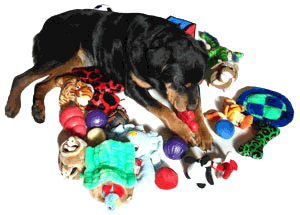
We love our pets and we want them to have loads of fun, so we buy them lots of toys and things to chew on. Unfortunately, toys and chewable products can lead to injury, expensive veterinary bills and sometimes even death. So what are 10 things you need to be aware of to minimise risk for you and your dog?
One: Pet proof the environment you are in.
You and your pet hang out at different places, right? Your home, your friend’s place, at the local cafe, the park etc. So it is important to scan the environment you are in to look for and remove potential hazards, e.g. items that could be swallowed or destroyed, sharp objects, plastic bags, chemicals etc
Two: Use toys that are of appropriate size for your pet.
Toys that are too small have the potential to be swallowed or become lodged in the throat.
Three: Observe the condition of tennis balls and other toys.
The outer “fuzz” of a tennis ball can cause problems and these thin, hollow balls can be chewed into small indigestible pieces. Discard balls once a change in shape or structure poses a risk hazard. A thicker, sturdier rubber ball (of appropriate size) or a frisbee is a safer solution. Discard toys that start to break into pieces or are torn.
Four: Supervise play with squeaky toys.
Your pet may feel that they must find and destroy the source of the squeaking, which means they could ingest it if left without supervision.
Five: Avoid or alter any toys that aren’t “pet-proof”.
Remove ribbons, strings, eyes or other parts that could be chewed off and/or ingested.
Six: Use rawhide products with caution.
Pieces of rawhide can get stuck in the esophagus or other parts of the digestive tract.
Seven: Select appropriate type and sized bones for your dog and only feed under supervision.
Only raw bones should be given to dogs as cooked bones can splinter and become choking hazards. The RSPCA recommends that bones must be large enough so that the dog cannot fit the whole bone in its mouth or swallow the bone whole. They also advise to avoid large marrow bones (these have very thick outer rims), T-bones, ‘chop’ bones e.g. lamb cutlets, large knuckle bones and bones sawn lengthwise (as done by some butchers) as dogs may crack their teeth on these, and to always feed bones under supervision. As the bone decreases in size, discard it, and any parts that fall off it, so they cannot be swallowed.
Eight: Consider whether toys/ chewable products are suitable to be left with your pet without supervision.
Remove any items that could become a hazard. Products with high durability and of the appropriate size are the safest options. The Humane Society of the United States recommends as one option, durable rubber toys for dogs, such as Kongs or Nylabones.
Nine: Don’t forget the stuffing.
The Humane Society of the United States recommends checking the labels on stuffed toys to see that they are labeled as safe for children under three years of age and that they don’t contain any dangerous fillings. They advise that problem fillings include nutshells and polystyrene beads, but even “safe” stuffings aren’t truly digestible. Remember that soft toys are not indestructible, but some are sturdier than others.
Ten: Discuss near misses and incidents with family and other dog owners.
This will help other family members and pet owners to become aware of potential hazards. Plus, sometimes we don’t realise something is a hazard until we hear about a near miss or incident.

